There’s an art to camping comfortably, which, like all art, takes some practice and preparation. When I told my friends I’d be camping for two weeks at Ucluelet, there was a pretty even divide between those who oohed enviously and those who seemed horror-struck — “what, sleeping on the ground?!?” For some, camping seems to mean privation, an endless series of inconveniences and discomforts to be avoided at all costs. Which is too bad, because some of them are favourite people with whom I’d love to share the West Coast experience. And I’d like to share it with you, too, even if I can’t take you camping — this is part two of a week-long series about various aspects of my recent trip to the West Coast. If you missed Part One, about the beaches of Pacific Rim National Park, it’s here.
A growing travel phenomenon around the globe these days is “Glamping” — a combination of the words “glamour” and “camping”. It involves travelling to exotic, sometimes remote places and staying in tents, treehouses, yurts, teepees, geodesic domes, cabins — and having all the amenities provided for you. Basically, it’s luxury camping, and it goes a long way back as a concept — the rich have been glamping for millennia whenever they travelled, with servants to pitch their tent, do the planning and the packing and the cooking, and so on.
Nowadays, there is a wide range of prices available, so that not only the ultra rich can afford this — it’s often more in the price range of a hotel. But since one of the reasons I stay in campgrounds rather than a cabin or hotel is because I can’t afford the latter for a two week stay, I’ll pitch my own tent (and I’m rather proud of still being able to so). Not that I wouldn’t go on a proper glamping vacation if I suddenly won the lottery! But for now, it’s DIY glamping for me.
Staying in a tent doesn’t have to be a punishment. I love the cozy cave-like feeling, while still being able to hear the night sounds (after the surfers have gone to bed, anyway) and breathe the fresh air. It’s all in how you furnish your tent! Over the years I’ve done a lot of camping, both minimalist and DIY-luxurious, and I’ve developed a lot of tricks for making things comfy, if not downright fancy. After all, this is not backpacking, it’s car camping, and you can bring whatever you can reasonably fit in your car!
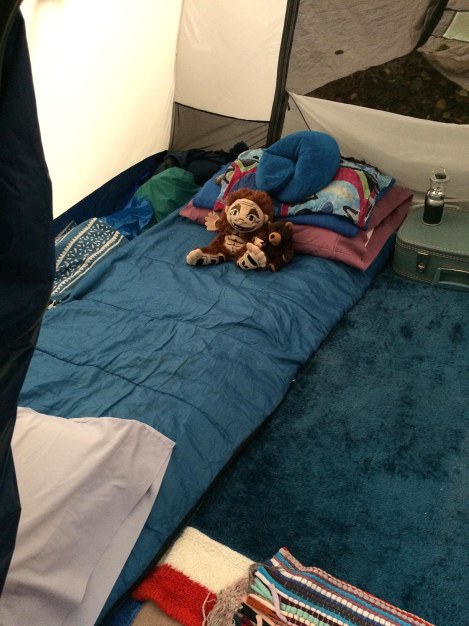
Here are some of my recommendations:
First, make sure you’ve got good padding for the bottom of your tent. I always put a tarp underneath to protect the floor (this is still advisable even if you have one of those bucket-style tent bottoms). If it’s gravelly, which this site was, add more tarps inside, or those blue foam insulating pads or even yoga mats. Some people use those foam squares that snap together for kids’ play areas; They’re great but I find the insulating pads easier to pack, as they roll up.
Then, rugs, rugs, rugs! I have an old packing blanket I keep in the back of the car which is perfect, then the thick car blanket goes over that, then some throw rugs — this time I brought the fuzzy throw I used to put in the cat carrier, and I think it’s going to be a permanent addition — it was so warm when I got up or sat on the floor! Sorry, future-cats. Especially have some small throw rugs for the entrance; you’ll want to shake those out frequently.
Make sure you have a really good mattress. Test it out at home before you go. Mine is a Luxury-Map Thermarest, a self-inflating pad, wide and thick; a little bit pricy, but it’s at least as comfy as my bed at home. I slid a blue camping pad under it this time — I actually bought it in Ucluelet after realizing that the gravel needed more padding than one folded-up tarp could handle, and was happy I did — I slept really well every night. For years I used one of those four inch foamies, then started doubling up two, which was getting a bit unwieldy (also they hold moisture, not good for long-term comfort on a damp coast), so I decided to treat myself to the self-inflating one. Worth every penny, I say.
Bring real pillows. Bring the ones you’re used to. And bring layers of coverings — sleeping bags are often too warm and confining for my tastes. I use my bag for a blanket, with a sheet under it. After this trip, I’m going to modify the sheet. The coast is often very damp (it was 100% humidity one day and it was not raining) and while I found that the fleece sleeping bag liner I had slipped over the thermarest for a sort of fitted sheet stayed lovely and dry feeling, my cotton sheet felt cold, damp and icky. I’m now in the market for an alternative. My campmates swear by the silk ones they use, so that may be an option.
Bring a little case or box you can use as a bedside table. Nothing like trying to get your lamp to stay upright on an uneven surface! And while I’m on the subject, bring a couple of good, small LED lanterns. And a headlamp with a red-bulb and white-bulb setting. The red setting helps preserve your night vision, and that of your fellow campers. Those have completely replaced flashlights for me.
And bring your teddy bear. Somebody has to guard the tent when you’re out on the beach, right? I brought my Sasquatch, as well as Morris the Bear, who has been on many trips with me.

Tarps overhead — if you’ve got someone who’s good with tarps and ropes, get some giant tarps and put them over the whole camp! Our Tarpmeister, Mike, does this every year with two twenty-foot tarps. No worries if it rains; the entrances to the tents and central area of the camp stays dry, and mud doesn’t get tracked into the tents. Make sure that they are tensioned to let runoff go to appropriate areas, keep an eye on them if it rains, and be ready to make adjustments.
Tents you can stand up in — if you are not supple enough to do the contortionist act of trying to get dressed while bent over from the waist, this is a great boon to long-term camping comfort. I can just stand up in the centre of my small tent, the tan and blue one pictured here (I have a big, airy 10×10 palace I use when space permits), and it’s quite sufficient.
Vestibules — good for everything from kicking off your shoes so you don’t bring dirt into the tent to having a middle-of-the-night visit with a sturdy jar (who wants to walk all the way to the loo fending off the bears in the dark anyway?). Best tent invention since flexible poles! Bring a mat of some sort for a floor, or fold up another tarp. You can never have too many tarps.
Comfy chairs — most of the camp chairs seen here give me backaches after days of sitting around the fire in them. Mine is the director’s-style one with the little side table — I bought it from a neighbour at her garage sale for $5, and was really glad I did. Test out any chair you plan to bring by sitting in it for an evening for a few hours — pop some popcorn, watch a movie, then pay attention to how your back feels. If it twinges, get a different one.
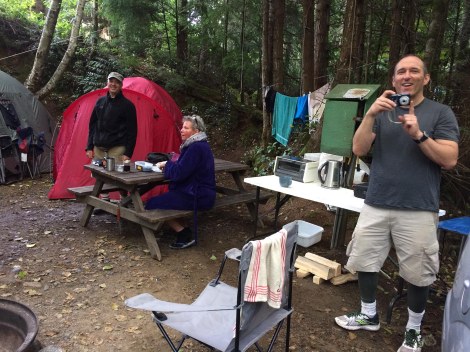
The crew — Alain, Victoria and Mike (and me) are a well-practiced camping team!
Electricity. Seriously! Pay a few bucks more and get an RV space. They come with electricity and water, so you can recharge cameras and phones, and plug in strings of fairy lights for cheerful, unobtrusive night lighting. And you can hook up a hose to the water faucet to direct water where you want it in your “kitchen”. We’ve gotten super decadent lately; it all started when Mike realized that we could bring the electric kettle instead of having a pot of water on a tripod over the fire (or firing up the camp stove). Hot water is one of the best conveniences you can have at a campsite. That has expanded into a toaster oven (have you ever tried to make toast over a fire?) and an electric frying pan. We still use our camp stoves but since we have the electricity, it saves a lot of fuel.
Bring a sturdy extra table, if you have space. Flimsy camp tables are no joy to cook on, and we do cook full meals, during which we’re using the picnic table for prep and the extra table for the cooking.
Cooking: I confess, left to myself I’d live on trail mix, cereal, and cheese, but Victoria is a fabulous cook, Mike has a great pasta dish he does every year, and Alain is an expert at cooking sausages over the fire — so I pitch in too. You’d cook at home anyway, right? So why not enjoy good food at camp? You don’t have to live on spam and s’mores! You don’t even have to plan everything in advance if there is a store within reach. Just bring some versatile staples, and supplement with fresh food every few days.
Systems: We’ve been doing this a long time together, so we’ve worked out some standard things. Agreeing beforehand on some basic scheduling preferences, things you want to do, what to do if everyone doesn’t want to do them, etc., can make the difference between a happy camping crew and a bunch of people who don’t want to speak to each other again. Remember, you’re all living together for the duration.
One thing we do is designate one of the two cars we come in (because we bring all this stuff, right?) as the beach car, and one as the larder. Food and food-related items should not ever be left out where wildlife can get at it; at the very least you’re inviting mice, and at the worst, you might find a bear wanting to join you for a midnight snack. So we lock it all in the car, covered (Yogi and Boo-boo know what a cooler looks like). I was camping once in a quite sedate little campground near White Rock, and the neighbours in their RV left the remains of dinner out on their table. I was awakened in the middle of the night by a raccoon party, squabbling and bouncing off my tent (which was pretty scary until I figured out what it was) and the neighbours were astounded to find the mess they had to clean up in the morning.
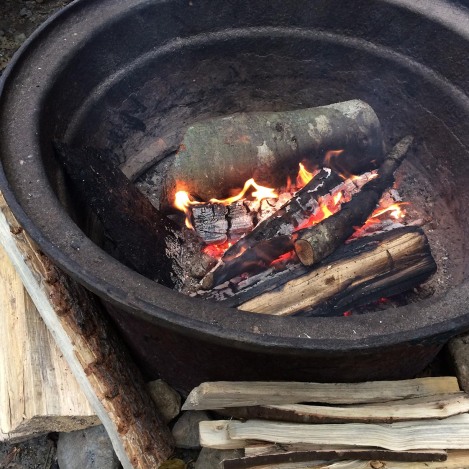
If allowed, have a fire. But don’t build it up like a bonfire. Keep it tight and small; you’ll get just as much heat out of it, and it’s much less wasteful and dangerous. Bring firestarters, little wax and sawdust sticks, and cut them up into small cubes (one of Mike’s tricks). Bring a grill to put across the pit; many campgrounds will lend you one, but you don’t know where that thing has been! Pro tip — other campers often leave unburnt wood when they go away, and there’s no harm in asking if you can have it; even a big charcoal hunk left in the firepit has some good burning left in it. When you go, pass on your leftover firewood to your neighbour. It’ll make them smile.
Even with all the electric appliances, we do some cooking over the fire. Some things just taste better that way. We bring cast-iron pans and big toasting forks, and grilling cages. For some reason nobody likes s’mores but me, and I can only manage one (I’m sure I could eat ten of those things when I was a kid!) so we don’t do those.
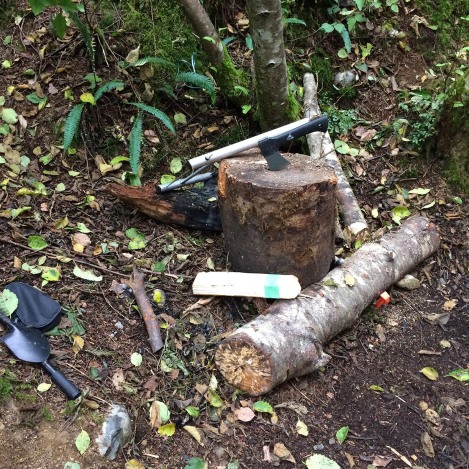
Come equipped to deal with splitting wood and some minor earth moving in case of uneven ground or rain. A hatchet and a small trowel may be all you’ll need, but a saw of some kind can be handy too. Mike actually has a pocket chainsaw (I think from Lee Valley) which fits in a little tin! I bring a garden trowel, which has come in handy for a bit of small-scale hydraulic engineering during the torrential downpours that can occur, sometimes for days, on the coast. It is a rainforest, after all (which is why we were able to have a fire — there is serious fog drip every day, even when it’s not raining).
We were fortunate that the camp had been clearing some overgrowth and made the logs available to campers, but they were kind of green, so we would stack the split wood on the outside of the firepit to dry before we used it. Otherwise we bought some wood and scavenged some.
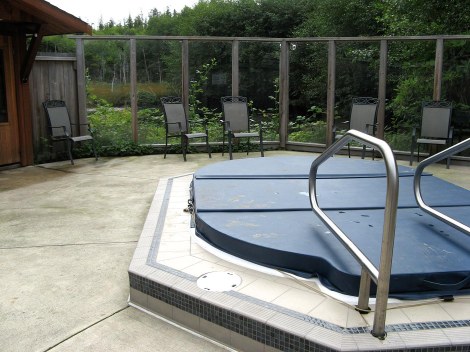
OK, here’s the TRUE secret to DIY glamping: pick a campground with good amenities. Ask your friends for recommendations. Clean showers are a must. Flush toilets are pretty nice, and you may consider them a must if you like, too, but for me not essential if the privies are kept very clean. The facilities in our campground are all looked after well by the hard-working and cheerful staff. But the best thing of all about this campground that we like, Surf Junction, is that it has a hot tub and sauna! I took this pic a few years ago when no one was in there; it’s kind of gauche to pop into the hot tub and take photos of strangers in their swimsuits, after all. It’s open to the skies, and the glass wall looks out over a little lake. Given how cold one can get out on the beaches, or on a cold day at camp, this is a lifesaver — I think every campground should have one!
The camp store has all kinds of stuff in case you’ve forgotten it (they’ll even rent you a tent, but you have to set it up yourself). And they have an espresso machine, and make the best hot chocolate I’ve ever had that I didn’t make myself.
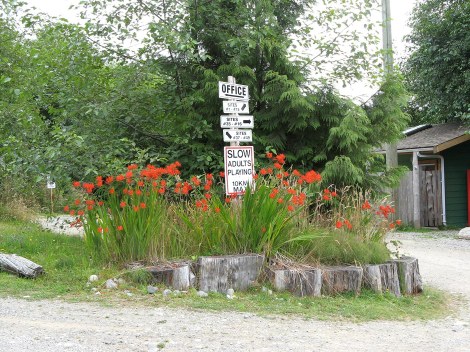
Pick a campground that is nice to hang out in, or somewhere nearby, in case you don’t feel like dashing off to the beach or a hike right away. Surf Junction is a pretty place, and nice to just walk around in. There’s a lovely big field where my companions went every morning for their yoga and stretches (I declined, finding just camping and walking on the beach quite enough exercise, but I was impressed by their dedication).
Don’t forget to play! Bring games and musical instruments. Sing some songs. Tell each other silly jokes. Be sure to bring a good book — not the one that you think you ought to read for your own good, but the fluffy space opera or mystery that you’d feel guilty being seen reading on the bus. Have plans for bad weather; if you are near a town, look up a list of fun things to do in advance.
One night we all went out in the field with mats and blankets and watched the stars come out — it was lovely to lie there talking quietly, watching for satellites and shooting stars and identifying constellations, and imagining all kinds of sci-fi scenarios inspired by a deep look into the Milky Way. How often have you done that since you were a kid? Me, not very — but I’d like to do it more.
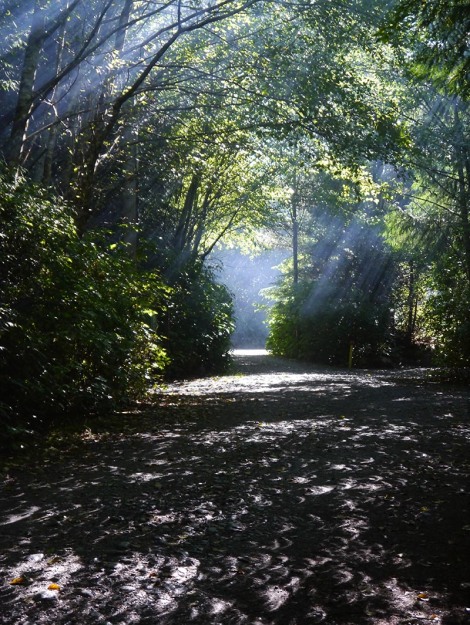
The road next to our campsite — taken during the Eclipse! See all the little crescents on the ground?
If you have an aversion to camping, and you’ve made it this far, good for you, and thanks for reading! I hope it will inspire you to try it sometime, in more comfort than you might have thought possible. If you do like camping, and are agog at the lengths we go to build our little camp, just remember that we’ve all done the minimalist thing in our time, but we’re getting to the age where a lot of people start thinking about RVs. We’re all agreed, we’ll cling to our tents — but a few extra comforts make a lengthy camp-out a lot more enjoyable.
Tomorrow: Part 3 — The eclipse, as seen from less-than-totality but with total fascination.
If you missed yesterday’s introduction to the series, about the beaches of Pacific Rim Park, click here.

totally agree… i would add only one thing… a small tent for ‘stuff’, not people ot food, but stuff that you don’t need cluttering up your small home away from home.
LikeLiked by 1 person
Yup — we’ve done that in situations where more space was needed; when I used to do fairs where the accommodations were camping by the booth, I’d bring a small tent to store my paper stuff in. But as you can see here, space was very tight (I was not allowed to bring my Palace, boo-hoo!) but we all have vestibules, which is what they are for. Also, as one car is the larder, it also got used for storage of things we wanted to keep away from the damp, like our art supplies and electronics (yeah, I brought my iPad).
LikeLiked by 1 person
Pingback: Total Fun with a Partial Eclipse | Karen Gillmore Art·
Pingback: An Aquarium Photo Safari | Karen Gillmore Art·
Pingback: The Wild Pacific Trail | Karen Gillmore Art·